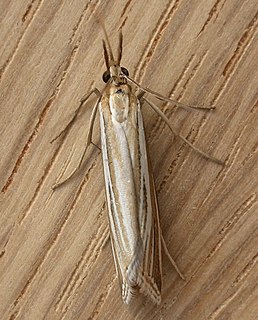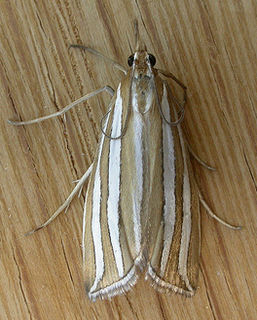
The Ngayarda languages are a group of closely related languages in the Pilbara region of Western Australia. The languages classified as members of the Ngayarda languages group are :

Cheiracanthium, commonly called yellow sac spiders, is a genus of araneomorph spiders in the family Cheiracanthiidae, and was first described by Carl Ludwig Koch in 1839. They are usually pale in colour, and have an abdomen that can range from yellow to beige. Both sexes range in size from 5 to 10 millimetres. They are unique among common house spiders because their tarsi do not point either outward, like members of Tegenaria, or inward, like members of Araneus), making them easier to identify. The name is a reference to the backwardly directed process on the cymbium of the male palp. The species epithet is derived from the Greek Ancient Greek: χείρ, romanized: cheir, meaning "hand", and Acanthium, a genus of thorny-stemmed plants.

Lycosa is a genus of wolf spiders distributed throughout most of the world. Sometimes called the "true tarantula", though not closely related to the spiders most commonly called tarantulas today, Lycosa spp. can be distinguished from common wolf spiders by their relatively large size. This genus includes the European Lycosa tarantula, which was once associated with tarantism, a dubious affliction whose symptoms included shaking, cold sweats, and a high fever, asserted to be curable only by the traditional tarantella dance. No scientific substantiation of that myth is known; the venom of Lycosa spiders is generally not harmful.

Hednota relatalis is a moth of the family Crambidae described by Francis Walker in 1863. It is found in Australia, in Australian Capital Territory, Victoria, Tasmania, South Australia, and Western Australia.

Hednota pleniferellus is a species of moth of the family Crambidae. It is found in Australia, in Queensland, New South Wales, Victoria, and Tasmania.

Hednota is a genus of moths of the family Crambidae.
Hednota ancylosticha is a moth in the family Crambidae. It was described by L. E. Koch in 1966. It is found in Australia, where it has been recorded from Western Australia.
Hednota cotylophora is a moth in the family Crambidae. It was described by Turner in 1942. It has been recorded from Western Australia. It can also fly.
Hednota demissalis is a moth in the family Crambidae. It was described by Francis Walker in 1863. It is found in Australia, where it has been recorded from Western Australia.
Hednota diargyra is a moth in the family Crambidae. It was described by Turner in 1925. It is found in Australia, where it has been recorded from Western Australia.
Hednota dichospila is a moth in the family Crambidae. It was described by Turner in 1937. It is found in Australia, where it has been recorded from Western Australia.
Hednota hagnodes is a moth in the family Crambidae. It was described by Turner in 1942. It is found in Australia, where it has been recorded from Western Australia.
Hednota koojanensis is a moth in the family Crambidae. It was described by L. E. Koch in 1966. It is found in Australia, where it has been recorded from Western Australia.
Hednota odontoides is a moth in the family Crambidae. It was described by L. E. Koch in 1966. It is found in Australia, where it has been recorded from Western Australia.
Hednota peripeuces is a moth in the family Crambidae. It was described by Turner in 1942. It is found in Australia, where it has been recorded from Western Australia.
Hednota recurvellus is a moth in the family Crambidae. It was described by Francis Walker in 1863. It is found in Australia, where it has been recorded from Western Australia.
Hednota tenuilineata is a moth in the family Crambidae. It was described by L. E. Koch in 1966. It is found in Australia, where it has been recorded from Western Australia.
Hednota vetustellus is a moth in the family Crambidae. It was described by Francis Walker in 1863. It is found in Australia, where it has been recorded from Western Australia.





